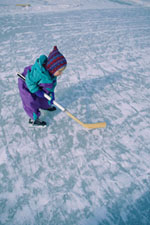 Object Of The Game
Object Of The Game
A game of ice hockey starts with a face-off at the center-ice face-off circle. When the referee drops the puck, the opposing centers try to gain possession, or direct it to a teammate. Either by passing the puck to a teammate in a better position, or by "carrying" the puck himself, a player for the team in possession tries to gain a position on the ice where he or she can take the best possible shot on the opponent's net. The greater the number, and the better the shots on goal a team take, the better its chances of scoring.
Except when a player has been sent off the ice to serve a penalty, there are six players for each team on the ice at any one time: a goalie (goaltender, goalkeeper, netminder), two defensemen, and three forwards. The two defensemen play on either side of the rink and are thus called the left and right defensemen. The three forward positions are left wing, center, and right wing.
Because hockey is a fast paced, highly aerobic, game that requires players to expend a great deal of energy in short bursts, hockey teams sometimes carry as many as 18 to 20 players, although youth hockey teams are usually smaller, especially at the very young levels. Included are three forward lines and at least two pairs of defensemen, who rotate onto the ice (play shifts) about every 1 1/2 to 2 minutes. Most teams will carry two goaltenders, but usually one plays an entire game. His only rest comes when there is a stoppage of play whistled by the referee or a linesman, when the puck is at the other end of the rink (though he must remain alert), and during between-period intermissions, which vary in length depending on the age of the players, but usually last 10 to 15 minutes.
Unlike most other sports, ice hockey does not require that changes in personnel be made only when there is a stoppage in play. Substitutions (called "line changes") often occur "on the fly." Because there may be non-stop action for a period of several minutes without a whistle stopping play, a player may skate over to his bench just off the ice surface and immediately be replaced by a teammate who plays the same position. The hazards of changing personnel on the fly are twofold: if it is not done at just the right time the opposing team may be able to take advantage of the temporary shortage in manpower to create an "odd-man rush"; and, if confusion occurs during the line change, a team may end up being penalized (too many men on the ice).








